sciware
Sciware
Documentation
How to win users and influence science
https://sciware.flatironinstitute.org/20_Documentation/
https://github.com/flatironinstitute/sciware/tree/main/20_Documentation
Rules of Engagement
Goal:
Activities where participants all actively work to foster an environment which encourages participation across experience levels, coding language fluency, technology choices*, and scientific disciplines.
*though sometimes we try to expand your options
Rules of Engagement
- Avoid discussions between a few people on a narrow topic
- Provide time for people who haven’t spoken to speak/ask questions
- Provide time for experts to share wisdom and discuss
- Work together to make discussions accessible to novices
(These will always be a work in progress and will be updated, clarified, or expanded as needed.)
Zoom Specific
- If comfortable, please keep video on so we can all see each other’s faces.
- OK to break in for quick, clarifying questions.
- Use Raise Hand feature for new topics or for more in-depth questions.
- Please stay muted if not speaking. (Host may mute you.)
- We are recording. Link will be posted on #sciware Slack.
- Please keep questions for the speaker in the Zoom chat.
Future Sessions
- Suggest topics and vote on options in #sciware Slack
Today’s agenda
Documentation
- what & why: overview and scope for today
- how: writing docs for functions, with exercises
- how: tools for nice docs (web-facing, manuals, etc)
Documentation: Principles and Definitions
Alex Barnett (CCM)
What is documentation?
Text that helps one use and understand a code or software tool
- describe inputs & outputs for one or more routines
- fancy name: “API” = application programming interface
- Equally useful: “narrative” docs (free-form)
- motivation: what does this tool do?
- why better than tools X, Y? (eg: it’s 10x faster…)
- install instructions, examples, tutorials, pretty figures, bugs
- how to run a “hello world” example, test your install
(often in
README.md: the first thing web user sees on GitHub) - or more extensive: PDF manual, wiki, website…
Who is your audience?
Thinking from your audience’s point of view is crucial
- eg API: these two functions do exactly the same thing
(the code inside could be identical):
beta = linear_regression(X,y) estimates regression weights beta given a feature matrix X and response vector y.x = linsolve(A,b) solves in the least-squares sense the possibly rectangular linear system Ax=b, where A is a MxN matrix, etc...Stats audience vs math audience - which do you want?
-
Choosing a good name for the function (= what it does), is part of good doc!
- Choose good names for arguments in the docs (
betais a typical name for unknown vector in stats, but in physics/math would confuse…)
What focus on today?
- User-facing: read by users (not developers) of your code
- this includes your future self: <6 months you forget how to call own code!
- Overview, general advice, pointers
- later: API docs, with exercises!
- finally: nice tools for narrative docs, including web-facing
Won’t talk about today, but related & important
- writing tests for your code/function (can integrate into docs)
- choosing a good interface (API) for your code/func
- um, your algorithms :) (the body of your code)
- good commenting of code, but…
- comments are not docs! user should not have to look down there!
- discussion/documentation of bugs (eg GitHub Issues)
- academic papers showcasing your package
API Documentation: how do I call function X?
- self-contained text “docstring” or comment block at top of each function
- printed when do
helpor?. Can be gathered to website (eg via Doxygen) - be as precise and specific as you can about inputs and outputs
- what are the edge cases? what behavior should happen in those cases?
- assumes an audience that is already invested in using your work (does little to explain big picture or sell your work to new users)
##
In high-level languages, API doc accessed from command line, eg
In [1]: ?range
Init signature: range(self, /, *args, **kwargs)
Docstring:
range(stop) -> range object
range(start, stop[, step]) -> range object
Return an object that produces a sequence of integers from start (inclusive)
to stop (exclusive) by step. range(i, j) produces i, i+1, i+2, ..., j-1.
start defaults to 0, and stop is omitted! range(4) produces 0, 1, 2, 3.
These are exactly the valid indices for a list of 4 elements.
When step is given, it specifies the increment (or decrement).
This is called inline documentation.
The range(4) example is good: can read to understand quickly
Many people simply modify examples for their purposes
The bang (!) sentence we find unclear (“stop” is bad argument name?) </div>
API docs for a function
You should aim to break up any repeated task (no matter how small) into a self-contained function with a docstring.
Eg, well-known and useful MATLAB/Octave quadrature function gauss.m (not part of core language):
% GAUSS nodes x (Legendre points) and weights w
function [x,w] = gauss(N)
beta = .5./sqrt(1-(2*(1:N-1)).^(-2));
T = diag(beta,1) + diag(beta,-1);
[V,D] = eig(T);
x = diag(D); [x,i] = sort(x);
w = 2*V(1,i).^2;
end
It’s clear from source code that outputs are x and w, but…
When you ask for (interactive) help, it prints only the docstring, which in MATLAB/Octave is the first contiguous % comment block:
>> help gauss
GAUSS nodes x (Legendre points) and weights w
Hmm, why not useful? [Please shout out the many reasons why]
Better docs for gauss.m
>> help gauss
GAUSS Nodes (Legendre points) and weights for Gaussian quadrature on [-1,1]
[x,w] = gauss(N) computes N nodes x and N weights w for Gaussian quadrature
on the 1D interval [-1,1]. The run-time scales as O(N^3). For example, for f a smooth
function, [x,w]=gauss(16); dot(f(x),w) approximates the integral of f from -1 to 1.
Inputs:
N - number of nodes, a positive integer (recommend 1000 or less)
Outputs:
x - N*1 double-precision vector of nodes, which each lie in [-1,1]
w - 1*N double-precision vector of corresponding weights
Note: increasing N usually gives more accuracy in the approximating the integral.
Note: precise math description, types/sizes of inputs & outputs, helpful advice to newbies teaching example of quadrature use
- API docs crucial in low-level languages too: Fortran/C/C++ users just read source code comment block at top of each function.
Final API advice
- Learn and follow docstring style for your language
- eg: how to annotate variable types, [optional] inputs
- Can you avoid biology/physics/etc terms in your docs?
- avoid jargon, instead try describe using accessible math
- API docs are easy to maintain: docstring right next to source code!
-
Limitation: function-by-function not often the best way to understand a package
- case in point re complex package: https://portal.hdfgroup.org/display/HDF5/HDF5
The Triangle: API, Test, Documentation
Q: What order should you write these in?
A: Write them all at once!
Good practices are mutually interdependent (Jeff makes this point every Sciware)
Alex recommends: write doc first, then test, only then function body!
- this gets the brain thinking about what task you want to do first
- then how you’ll know your code did it right
- ok, finally you have to figure out how actually to code it :)
READMEs overview
“What is this package and how do I get and run it?”
-
eg: https://github.com/danfortunato/ultraSEM
- Audience:
- New users of the software
- People who may be calling your code as a step in a pipeline (rather than interacting with your functions as an API)
- Tells users how to install the package & make sure it works
- Describes some of the functionality but probably only scratches the surface of what your code can do
- Sometimes a good README simply redirects to a more elaborate website doc: https://github.com/dfm/emcee
Narrative docs overview
- “What can this package do” to “Tell me technical details about this package”, user manual.
- Eg FINUFFT (ReadTheDocs+sphinx+mathjax for LaTeX): https://finufft.readthedocs.io/en/latest/index.html
- Audience:
- People you’re trying to convince to use your tool
- Those seeking details about features and workings
- Can include rationale, design decisions, or more sophisticated configurations
- Needs additional work to make sure it stays up to date as code changes
- Essential for any reasonably mature package
Tutorials overview
- “Step-by-step example of solving ABC using XYZ”
https://emcee.readthedocs.io/en/stable/tutorials/quickstart/ https://github.com/fruzsinaagocs/oscode/blob/master/examples/cosmology.ipynb
- Fully worked (and working!) examples: many learn by example
- Ideally cover the full gamut of what people would want to do with your tool
- how to solve a particular problem rather than how to use a particular function
- Audience: everyone, start with novice user, then advanced
- make sure it stays up-to-date as your code/APIs/design decisions change!
Documentation is a form of publication
Your work only makes a difference if people use it.
It will only get widely used if it’s easy to understand and use.
Once you have written a stable code, writing docs takes time, but is well worth it!
It is just as important as publishing papers, conference talks, etc
Job candidates in scientific computing are assessed by their docs & code
Writing API Documentation
Bob Carpenter (CCM)
The doc/test/code triangle
- When desiging a function, consider together
- Documentation: says what the code does
- Testing: tests it does what it says it does
- Code: the code itself
Hints of trouble
- if code is hard to doc, it’s probably badly designed
- if code is hard to test, it’s probably badly designed or poorly documented or both
Exercise 1
- In your favorite language, design a function to sum a sequence of values.
- Write documentation for it.
- Ask yourself if you can write complete tests for it only looking at the doc.
def mySum(v) ...
template <typename T>
T mySum(const std::vector<T>& v) ...
Answer 1: C++ Documentation with Doxygen
/**
* Return the sum of the specified inputs. Starting from
* a nullary value for the return type, elements of the
* argument are added in order using `operator+=<T>()`.
*
* Example usage and output:
* ```cpp
* double x = mySum<double>({});
* int n = mySum(vector<int>{1, 2, 3});
* string s = mySum(vector<string>{"hello", " ", "world"});
* cout << "x = " x << "; n = " << n << "; s = " << s << endl;
* ```
* ```
* x = 0; n = 6; s = hello world
* ```
*
* @tparam T type of arguments
* @param v vector of arguments
* @return sum of the elements of v
*/
template <typename T>
T mySum(const std::vector<T>& v) {
T sum = T();
for (const T& x : v) sum += x;
return sum;
}
Answer 1: More questions
- C++ is very strict
- all arguments have to be of same type because argument type is
vector<T>and there’s noObjectlike in Java - the concept (usage of
T) requiresTto supportT()andoperator+=<T>.
- all arguments have to be of same type because argument type is
- What about R, Python, or Julia?
- how did you document argument and return types? and shapes?
- did you consider non-numeric inputs?
- how about clients mixing numbers and strings?
Exericse 2
- Consider writing a function
myAvgto calculate the average of an array.- How does the documentation differ?
- How will testing differ?
- Do the same for
mySDthat calculates the sample standard deviation of an array.
Exericse 2, More questions
- What about
myAvgand zero-length inputs? (div by 0?) - Inputs are numeric, what is output type for integer input?
- What about the two definitions of
mySD?- divide by
sizeis the maximum likelihood estimate - dividing by
size - 1gives an unbiased estimate
- divide by
New Flatiron Wiki
We’d greatly appreciate your feedback.
- Slack: @Geraud Krawezik / @Liz
- Email: gkrawezik@flatironinstitute.org / elovero@flatironinstitute.org
Survey
https://bit.ly/sciware-docs
Tools to Generate Documentation
How do people write user documentation for scientific software projects?
Lehman Garrison (CCA)
Categories of Documentation
- As before, let’s consider tools in two categories of documentation
- Narrative documentation: high-level, “instruction manual” prose
- API documentation: granular technical specifications
Tools for Narrative Documentation
- In order of increasing feature-richness and complexity
README(Markdown and reStructuredText)- Wiki
- Jekyll + static web hosting (e.g. GitHub Pages)
- Sphinx + ReadTheDocs
Narrative Documentation: the README
- Simplest form of top-level documentation
- Highly portable, easily read as a webpage or in a terminal
- Often where you will start documentation—don’t underestimate the usefulness!
- Great idea to jot down the steps to run your code in a
READMEas soon as you start - We all promise ourselves we’ll set up beautiful documentation later, but in case that doesn’t happen, a
READMEis a lifesaver
- Great idea to jot down the steps to run your code in a
- GitHub and other hosting sites will render your
README
Formatting the README
- Two popular languages to make your plain-text
READMElook nice online:- Markdown (
README.md) - reStructuredText (
README.rst)
- Markdown (
- Markdown is a little easier to write, RST is more feature-complete
- “GitHub-Flavored Markdown” is used throughout GitHub; RST is commonly used on ReadTheDocs with Sphinx
Formatting the README
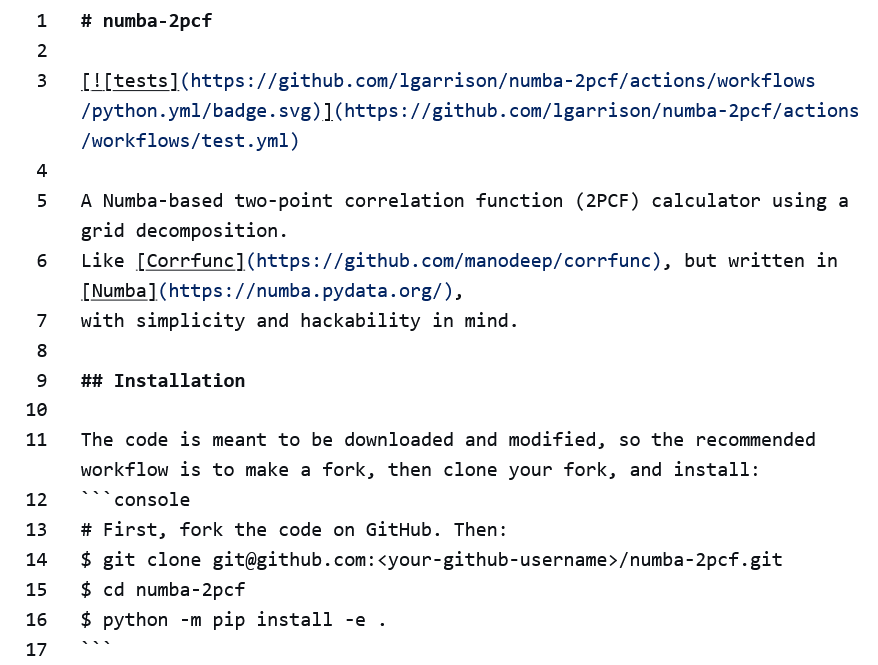
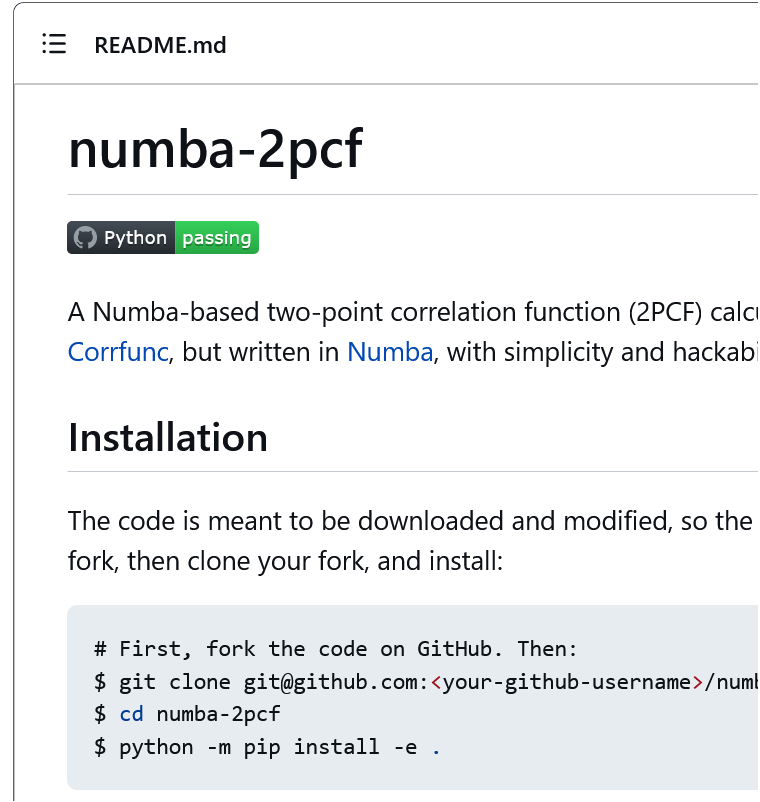
Formatting the README: Markdown
- Plain text format for writing structured documents
- Highly readable in its raw form
- but also renders into pretty HTML (or PDF, etc)
- These slides are written in Markdown!
Formatting the README: Markdown Example
File: README.md
# my-cool-project
A one-sentence description of how **cool** my project is
## Installation
1. First step is to run this command:
`pip install my-cool-project`
2. Then try to follow the example below!
## Example
```python
import my_cool_project
my_cool_project.go()
```
If the example doesn't work, check the [Installation](#installation).
Formatting the README: Markdown Example
<img width=60% src=”assets/rendered_readme.md.2.png” class=”plain”>
Formatting the README: reStructuredText
- Still a plain text format, slightly more complicated than Markdown
- Supports more directives than Markdown
- Textual substitution
- Good integration with LaTeX
- References & footnotes
- Links between sections and pages
- Admonitions (call-out boxes)
- Sphinx has a good RST primer
Formatting the README: reStructuredText Example
File: README.rst (renders the same as the Markdown example)
my-cool-project
===============
A one-sentence description of how **cool** my project is
Installation
------------
``pip install my-cool-project``
Example
-------
.. code-block:: python
import my_cool_project
my_cool_project.go()
If the example doesn't work, try `Installation <#installation>`_.
Tools for Narrative Documentation: Wiki
- GitHub and other sites have built-in support for Wikis
- Good for long-form documentation (e.g. design philosophy, implementation details, etc)
- An easy next step when your documentation is too big for a single
READMEfile - Can clone from GitHub as its own repo:
git clone https://github.com/google/sanitizers.wiki.git
- GitHub Wiki usage seems to be declining in research software, in favor of ReadTheDocs
Tools for Narrative Documentation: Wiki Example

Documentation Tools: Jekyll + Static Hosting
- Jekyll is a tool for generating websites from plain text files, like Markdown
- Generates static webpages
- Can be hosted on any HTTP server (including Flatiron user www)
- No need to run a “Jekyll server”, or maintain a database, etc.
- These slides are rendered with Jekyll!
Documentation Tools: Jekyll + Static Hosting
- GitHub Pages natively supports Jekyll and will host the generated sites (
username.github.io/mycoolproject)- Will be built and deployed as a GitHub Action, like CI
- Go to the Sciware GitHub for a real example of Jekyll + GitHub pages!
- Source files are in GitHub-flavored Markdown, output is HTML website (the slides)
Documentation Tools: Sphinx + ReadTheDocs
- Sphinx is a tool that builds a website from plain text files
- Reads in reStructuredText (or Markdown)
- Outputs a website
- ReadTheDocs is a web host and cloud service
- ReadTheDocs pulls your GitHub repo
- Runs Sphinx on their servers to build the website
- Hosts the docs at
mycoolproject.readthedocs.io - Even hosts past versions (based on git branches/tags)
- Sphinx + ReadTheDocs is a powerful, popular combo!
Documentation Tools: Sphinx + ReadTheDocs
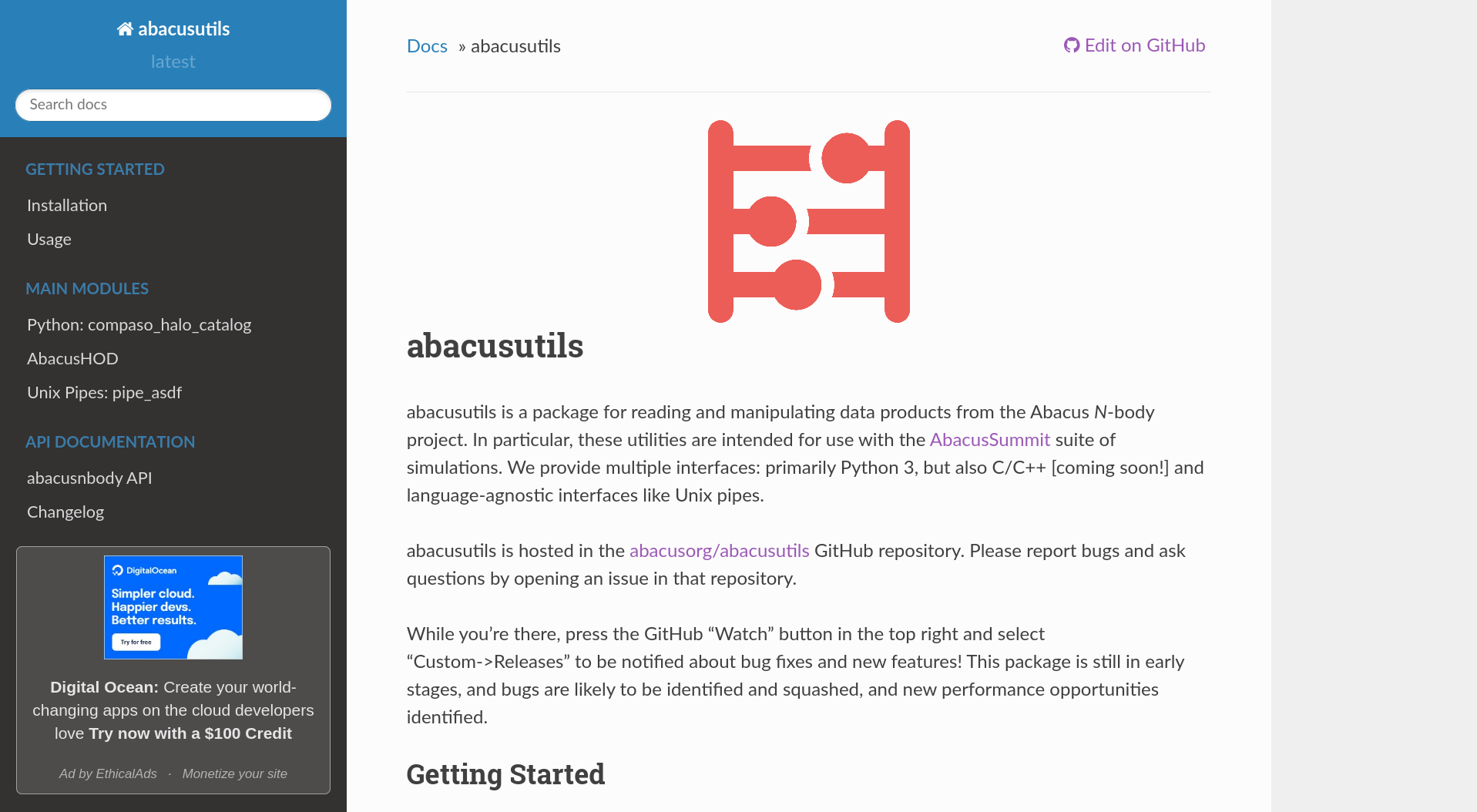
Documentation Tools: Sphinx + ReadTheDocs
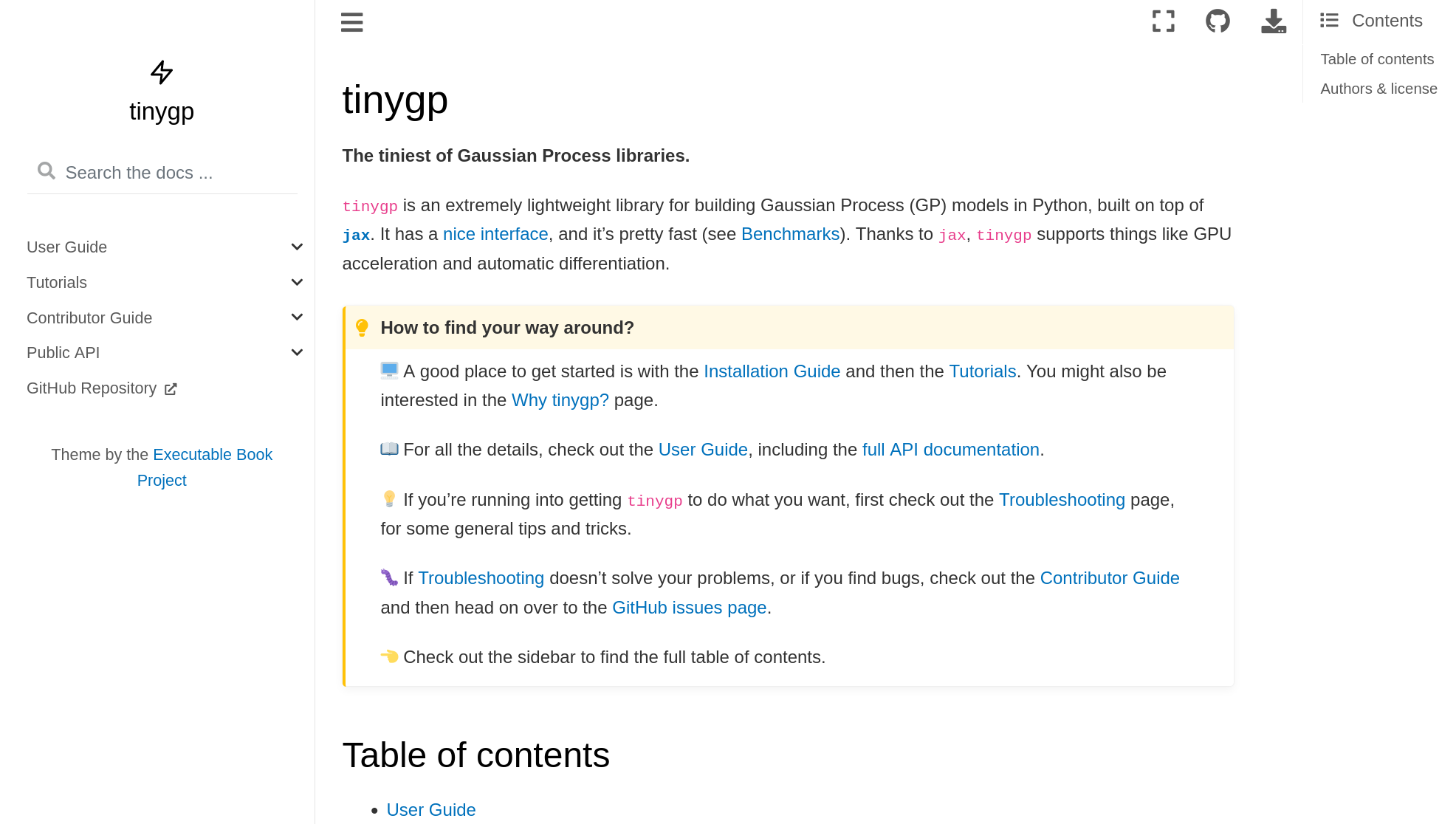
Documentation Tools: Sphinx + ReadTheDocs
- Sphinx
- Controlled by
conf.py: supports themes, extensions, and extensive customization - Inserts rich navigation features: search, outline in the sidebar, table of contents, etc
- Controlled by
docs/index.rstwill becomeindex.html(main page);docs/installation.rstwill becomeinstallation.html, etc.
What to put in narrative docs
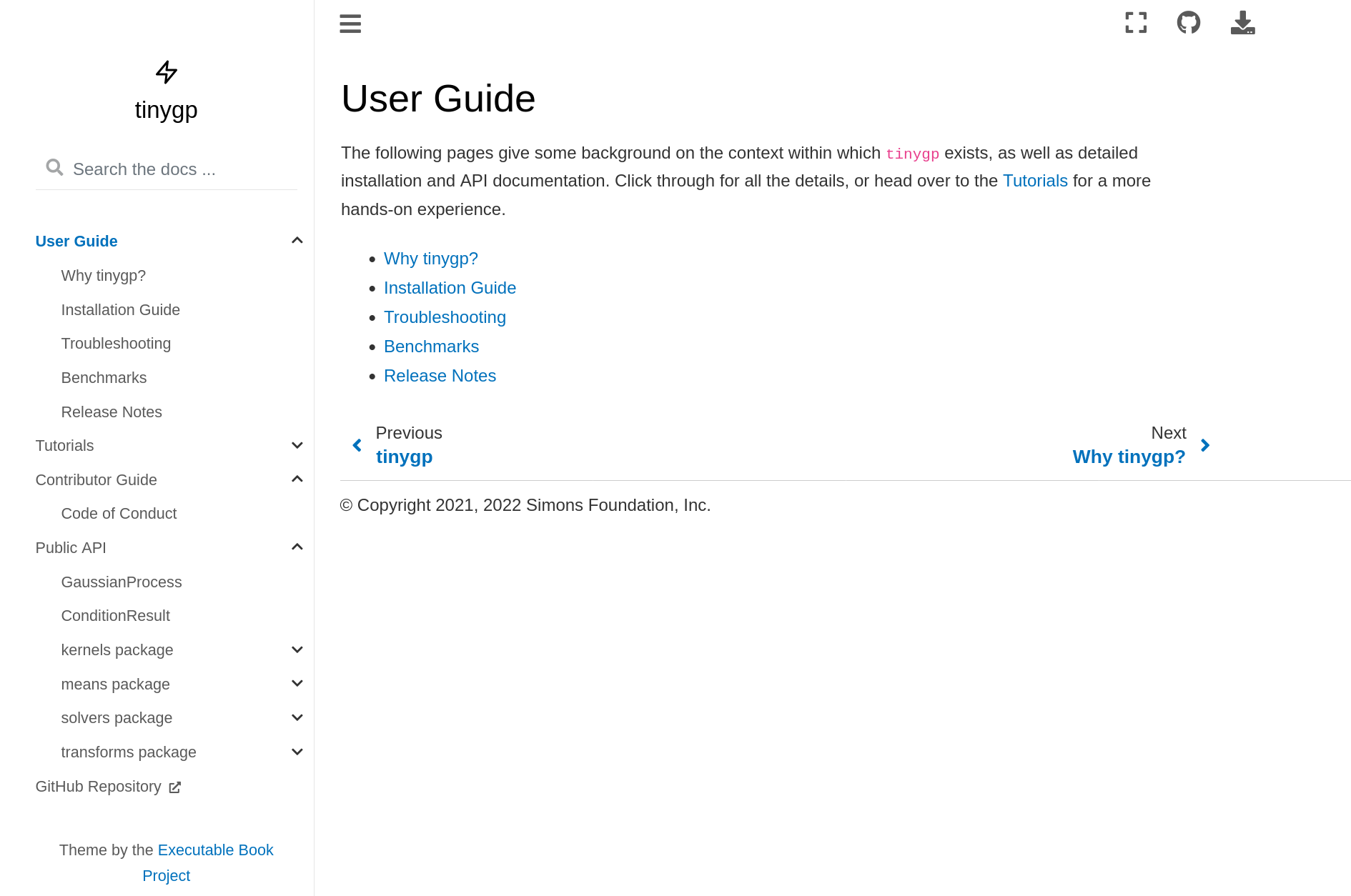
What to put in narrative docs
- Overview
- What problem does your package solve?
- Installation
- Usage / Examples
- Tutorials
- Release Notes / Changelog
- How to contribute (and link to repo!)
- How to report issues
- How to cite
- API (Sphinx autodoc can help generate this)
Documentation Tools: Sphinx + ReadTheDocs
Sphinx conf.py example (Full Documentation)
# conf.py
extensions = [
'sphinx.ext.autodoc', 'sphinx.ext.autosectionlabel'
]
# General information about the project.
project = "mycoolproject"
html_theme = "sphinx_rtd_theme" # the theme we all know and love
# but there are many others, like "sphinx_book_theme"
autosectionlabel_prefix_document = True
Documentation Tools: Sphinx + ReadTheDocs
An example of sphinx.ext.autosectionlabel:
File: index.rst
Introduction
------------
Hello, there! This is some text.
A link back to the section header: :ref:`index:Introduction`.
Documentation Tools: Sphinx + ReadTheDocs
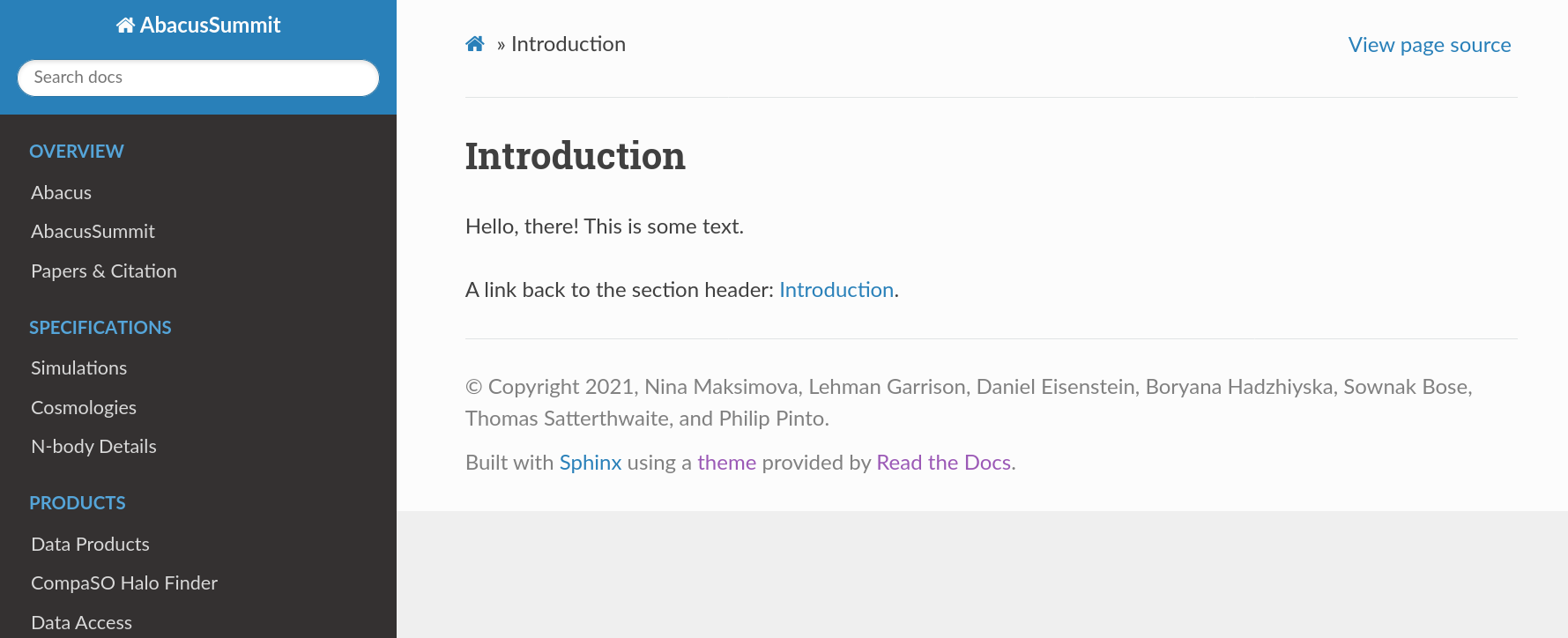
Documentation Tools: Sphinx + ReadTheDocs
Example of API doc generation with sphinx.ext.autodoc:
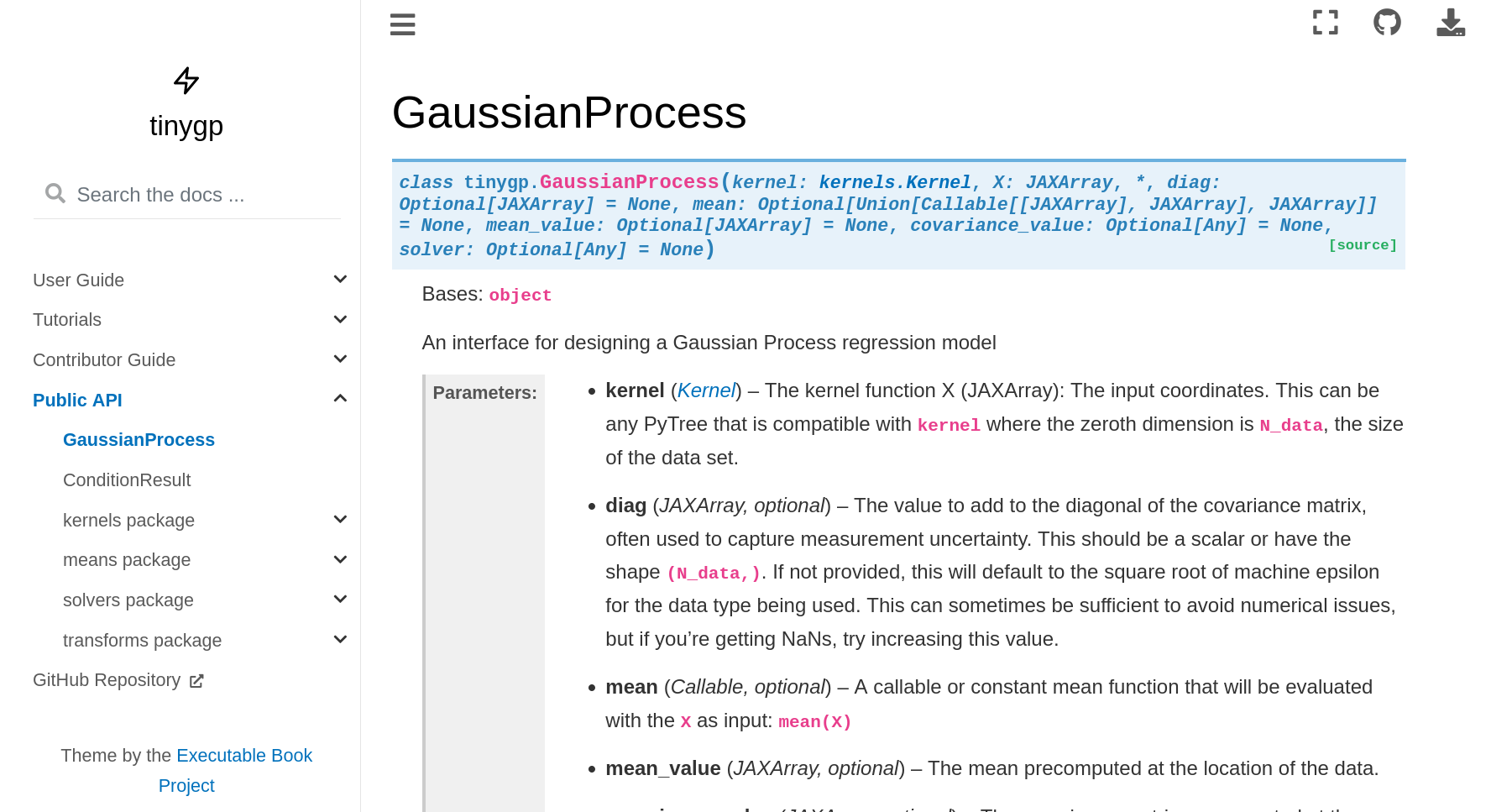
Documentation Tools: Sphinx + ReadTheDocs
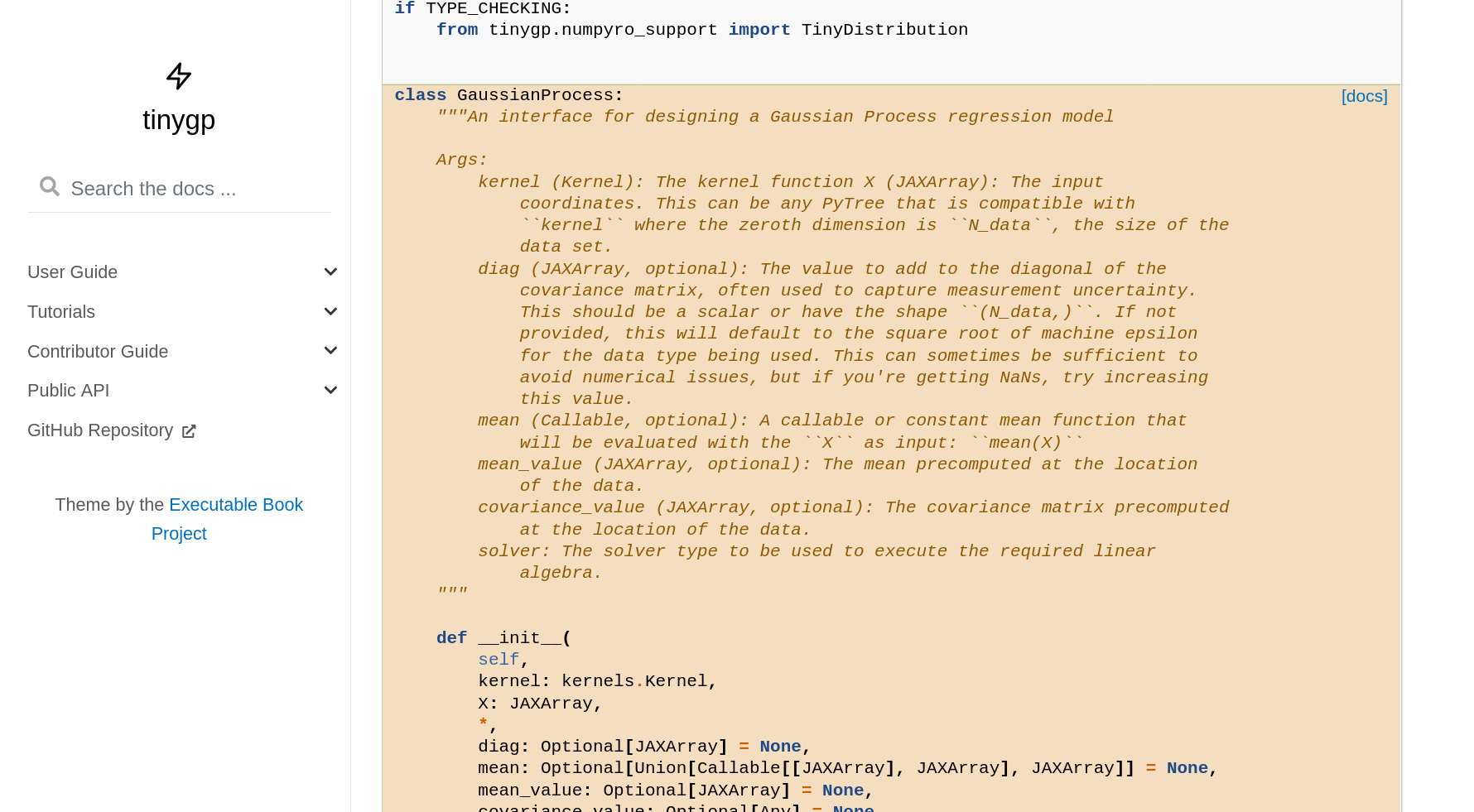
Other Useful Sphinx Extensions
- MyST-NB
- Executable documentation with sphinx-book-theme
- Write docs/examples in a Jupyter notebook
- MyST extension renders them as a Sphinx webpage
- Allow user to launch notebook in Binder/Colab
- Breathe
- Bridge between Doxygen (C/C++ docs) XML and Sphinx RST
- Built-in extensions
- doctest, githubpages, intersphinx, napoleon
Getting Started
- ReadTheDocs tutorial here, using a Sphinx template: https://docs.readthedocs.io/en/stable/tutorial/
- Create a Sphinx project from scratch: https://www.sphinx-doc.org/en/master/usage/quickstart.html